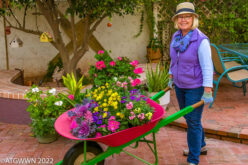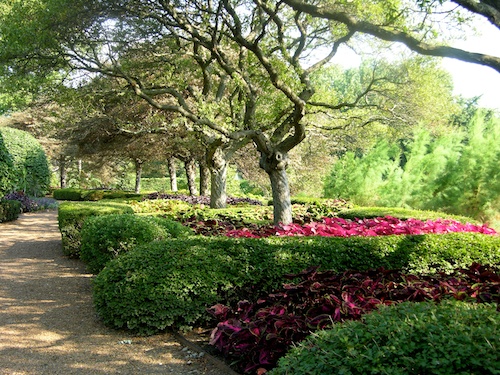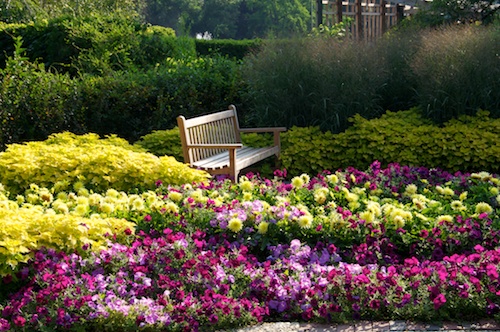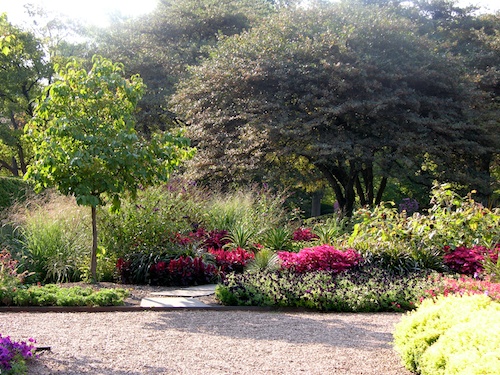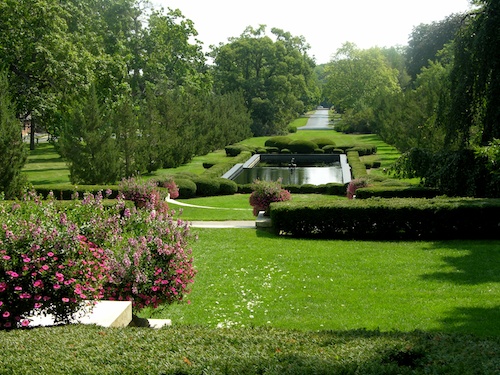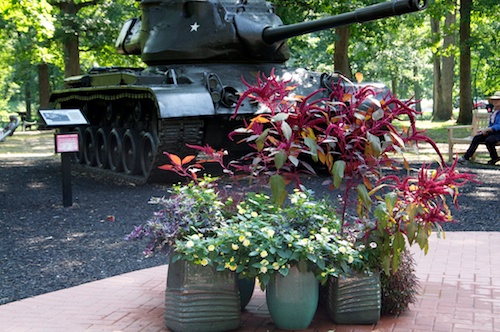 In all my wandering through beautiful gardens I never expected to see a row of military tanks landscaped with potted plants. A collection of 11 army tanks ranging from a 1917 WWI vehicle to the Abrahams tank of Desert Storm line up as if ready for inspection. The big guns now silent, sit under the shade of large oak trees. In Catigny Park, 30 miles west of Chicago, there is just such a scene. It startled me. It made me stop, sit down and think about military equipment in a beautiful garden. But then the profit of travel and exploring gardens is learning and here I had much to learn.
In all my wandering through beautiful gardens I never expected to see a row of military tanks landscaped with potted plants. A collection of 11 army tanks ranging from a 1917 WWI vehicle to the Abrahams tank of Desert Storm line up as if ready for inspection. The big guns now silent, sit under the shade of large oak trees. In Catigny Park, 30 miles west of Chicago, there is just such a scene. It startled me. It made me stop, sit down and think about military equipment in a beautiful garden. But then the profit of travel and exploring gardens is learning and here I had much to learn.
Catigny Park is a gift of Colonel Robert McCormick, editor and publisher of the Chicago Tribune for over 40 years, grandson of the founder of the Tribune Company, WWI Veteran and recipient of the Distinguished Service Medal awarded by General John J. Pershing in 1923. A story in history completely new to me.
Within the 500 acres of this park there are 29 acres of spectacular formal gardens. The gardens were designed in the 1960’s & 70’s by landscape architect Franz Lipp. Designed as pleasure gardens to encourage visitors to discover ideas for their own gardens, Catigny Park brims with wonderful ideas along the garden path. Waves of beautiful colored annual flowers surrounding a bench set under the shade of large trees pulls you in to sit and imagine this scene in your own back yard. Other ideas include geometric patterns accented by layers of perennials varying in height, texture and color. The gardens change with the seasons, spring displays tulips, daffodils and flowering trees, summer is full of color with coleus, sweet potato vines and zinnias. In the fall, chrysanthemums and changing foliage of oaks and hundreds of other trees provide a jaw dropping show. Path patterns, iron work fencing, sculpture, roses and whimsy provide plenty to enjoy for any plant enthusiast.
The McCormick Mansion, now a museum holding the story of “the Colonel’s” life presides over the garden. From all four sides the gardens stretch out in grand form. The back porch is a replica of Thomas Jefferson’s home. This is simply a spectacular set of gardens.
Set among the garden is a fascinating story of the family that left this garden to the public. In the late 1890’s the founder of the Tribune Company of Chicago, Joseph Medill,a gentleman farmer, owned 1500 acres at this site. His 35 room Colonial Style mansion was a home worthy of a name, which he dubbed Red Oak Farm. In the 1930’s the land served as an experimental farm testing crops and farming practices relevant to the Midwest. The Tribune ran a weekly column reporting the best practices to improve the lives of the readers. Grandson Robert McCormick inherited the land and the company. He was so transformed by his military experience in France during WWI he renamed the home Catigny (French pronunciation “canteeny”) in honor of the 1st battle won by American Forces in France in WW1 . McCormick created the First Division Museum, known as “Big Red One.” It is the Army’s first division on active service since June 8, 1917 in WWI. Here their stories are gathered, honored and displayed. There are scholarly people fascinated about military history who walk in knowing about Divisions, Brigades and troops. I walk in fascinated about flowers. Yet we all benefit by the creation of Cantigny Park.
I only wanted to see the beautiful flowers. Yet great gardens transform people by touching our emotions. Whether young and old, certain or unsure, nature lovers, military leaders, and everyone in between, gardens are there to connect us. But to have gardens whether grand or small “requires peace and prosperity” so writes Charles Quest-Ritson, author of “The English Garden, A Social History.” When people are struggling simply to survive, gardens don’t exist. Unless we have peace, some hope for a predictable future, we dare not plant seeds and expect to see them grow. Unless we have prosperity enough to set aside a spot of land to cultivate for food and flower, we won’t have gardens. According to the UN’s refugee agency as of June 2013, 45 million people, of all ages, are currently displaced by war. Crowded into refugee camps, living without peace and certainly without the prosperity to allow a patch of ground for a garden. Peace and prosperity are precious conditions. Our military stands ready to serve. Their service and sacrifice allows us today to walk among the flowers. Which is why it seems absolutely fitting to have a line of military tanks landscaped with pots of flowers.
Published in Roots & Shoots, http://cals.arizona.edu/maricopa/garden/mgcentral/uploads/randsnov2013.pdf
